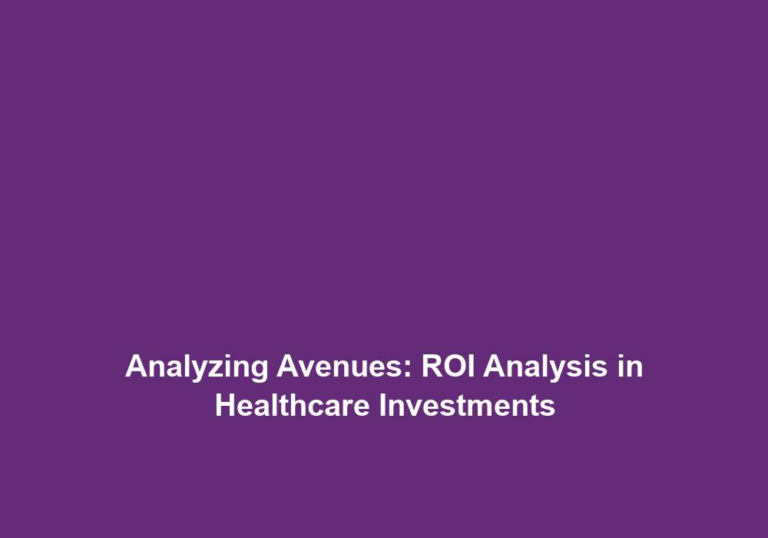Cashflow Clarity: The Importance of Revenue Cycle Management in Healthcare
In the ever-evolving world of healthcare, financial stability and cash flow management play a crucial role in the success of healthcare organizations. Revenue Cycle Management (RCM) is a strategic process that enables healthcare providers to effectively manage their financial operations, optimize revenue generation, and ensure smooth cash flow. This article aims to delve into the significance of revenue cycle management in healthcare, highlighting its key components and benefits.
Understanding Revenue Cycle Management
Revenue Cycle Management refers to the entire lifespan of a patient’s account, starting from the moment an appointment is scheduled to the final payment received for services rendered. It encompasses all administrative and clinical functions involved in the billing, collection, and management of patient revenue.
The revenue cycle in healthcare can be complex and multifaceted, involving various stakeholders, such as patients, healthcare providers, insurance companies, and government entities. Effective revenue cycle management streamlines the entire process, from patient registration and insurance verification to claims submission, denial management, and payment posting.
Key Components of Revenue Cycle Management
- Patient Registration: Accurate and detailed patient information is crucial for revenue cycle management. This includes demographic data, insurance coverage, and contact details. Efficient registration processes ensure the collection of necessary information and enable the verification of insurance eligibility.
- Collecting accurate patient information during registration ensures smooth billing and reimbursement processes.
- Proper documentation of patient demographics and insurance coverage helps avoid claim denials.
- Streamlined registration processes improve the overall patient experience and reduce administrative burden.
- Insurance Verification: Verifying insurance coverage and benefits prior to providing healthcare services is essential. This step helps prevent claim denials and ensures that patients are aware of their financial responsibilities. Timely verification saves both patients and healthcare providers from the hassle of claim disputes and payment delays.
- Insurance verification confirms patient eligibility and coverage, reducing the risk of claim denials.
- It helps healthcare providers estimate patients’ financial responsibility and communicate it effectively.
- Timely verification minimizes the chances of delayed payments and improves cash flow.
- Coding and Documentation: Proper coding and documentation of medical procedures and diagnoses are vital for accurate billing and reimbursement. Medical coders play a pivotal role in translating healthcare services into universally recognized codes, ensuring that claims are processed correctly and promptly.
- Accurate coding ensures that healthcare services are appropriately billed, preventing under or overbilling.
- Proper documentation supports the coding process and provides necessary evidence for claim submission.
- Trained medical coders help avoid coding errors, reducing the risk of claim denials and payment delays.
- Claims Submission and Adjudication: Once the coding and documentation are complete, claims are submitted to insurance companies for reimbursement. Revenue cycle management focuses on submitting clean claims, free from errors or missing information, to minimize claim denials. Adjudication refers to the process of insurance companies reviewing and deciding on the claims.
- Submitting clean claims enhances the chances of timely reimbursements and minimizes payment delays.
- Proper documentation and accurate coding help streamline the claims submission process.
- Adjudication ensures that claims are reviewed and processed efficiently, reducing the risk of denials.
- Denial Management: Claim denials can significantly impact cash flow and revenue generation. Effective denial management involves identifying the root causes of denials, appealing unjustified denials, and taking proactive measures to minimize future denials. Timely follow-up and resolution are critical to optimize revenue collection.
- Analyzing denial patterns helps identify areas for improvement in the revenue cycle process.
- Proactive measures, such as staff training and process enhancements, can reduce the frequency of denials.
- Timely follow-up and appeals for unjustified denials increase the chances of successful reimbursement.
- Payment Posting: Accurate and timely posting of payments received from insurance companies and patients is crucial for maintaining an organized revenue cycle. This step involves reconciling claims, applying payments to the appropriate accounts, and managing adjustments and write-offs.
- Timely payment posting helps track outstanding balances and improves cash flow management.
- Accurate reconciliation ensures that payments are correctly applied to patient accounts.
- Managing adjustments and write-offs helps maintain accurate financial records.
- Patient Collections: Revenue cycle management extends to patient collections, which involve collecting payments from patients for services rendered. Strategies for patient collections should be clear and transparent, ensuring that patients understand their financial obligations and providing options for payment plans or financial assistance when necessary.
- Clear communication about financial obligations and payment options improves patient satisfaction.
- Offering flexible payment plans and financial assistance helps patients manage their healthcare expenses.
- Well-defined collection strategies reduce the risk of unpaid balances and improve revenue collection.
Benefits of Effective Revenue Cycle Management
Implementing an efficient revenue cycle management system can yield numerous benefits for healthcare organizations:
- Optimized Cash Flow: By streamlining the revenue cycle and minimizing claim denials, healthcare providers can accelerate payment processing and improve cash flow. This translates to better financial stability and the ability to invest in resources, technology, and quality patient care.
- Optimized cash flow allows healthcare organizations to invest in new technologies and infrastructure.
- Improved financial stability enables the provision of quality patient care and enhanced services.
- Accelerated payment processing reduces the risk of delayed reimbursements and ensures consistent cash flow.
- Reduced Administrative Burden: An effective revenue cycle management system automates administrative tasks, reduces manual intervention, and minimizes errors. This allows healthcare staff to focus on patient care rather than being overwhelmed by administrative burdens.
- Automation of administrative tasks improves efficiency and reduces the chances of errors.
- Minimizing manual intervention frees up staff time, allowing them to prioritize patient care.
- Reduced administrative burden improves staff morale and job satisfaction.
- Improved Financial Performance: Effective revenue cycle management leads to increased revenue capture and timely reimbursements. Healthcare organizations can monitor key performance indicators (KPIs), identify areas of improvement, and optimize their financial performance.
- Increased revenue capture improves the overall financial performance of healthcare organizations.
- Timely reimbursements help maintain a positive cash flow and support business growth.
- Monitoring KPIs allows organizations to identify bottlenecks and implement performance improvements.
- Enhanced Patient Experience: Revenue cycle management aims to create a seamless and transparent financial experience for patients. Clear communication regarding insurance coverage, financial obligations, and payment options enhances patient satisfaction and fosters long-term relationships.
- Transparent communication about financial matters builds trust between patients and healthcare providers.
- Providing clear information about insurance coverage and costs reduces patient confusion and anxiety.
- Offering convenient payment options and financial assistance improves the overall patient experience.
- Compliance and Audit Preparedness: A well-structured revenue cycle management system ensures adherence to healthcare regulations and billing standards. This reduces the risk of compliance violations and provides healthcare organizations with a solid foundation for audits and financial reporting.
- Compliance with healthcare regulations minimizes the risk of penalties and legal issues.
- Well-documented revenue cycle processes support accurate financial reporting and audits.
- Adherence to billing standards helps avoid billing errors and potential compliance violations.
Conclusion
In the ever-changing landscape of healthcare, effective revenue cycle management is paramount for financial stability and success. By implementing a well-structured system that encompasses all key components, healthcare organizations can optimize their cash flow, reduce administrative burdens, enhance patient experiences, and improve overall financial performance. Embracing revenue cycle management is a strategic investment that sets the foundation for long-term growth and sustainability in the healthcare industry.







